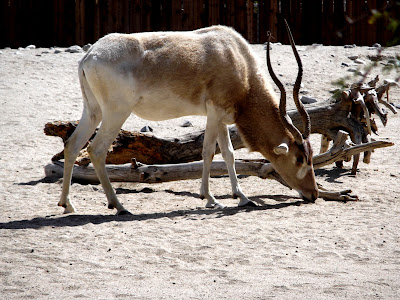This post is the birthday post of Govind Kamath! Happy birthday, Mr. Kamath! If you have a birthday coming up, just email me the date at cuyvaldar123946@gmail.com with the date and your favorite animal, and I will do my best to get a post in!
Over the years, you may have pondered, "Where does my burger come from?" You probably just meant where was the cow that it came from. But now here is something else for you to ponder. Where the heck did the cow even come from? Do you ever just see wild, black and white cows? Well, I am here to tell you all about the evolution of the cow.
 |
| A Watusi/Longhorn pileup! They actually crashed into each other, though! Trust me, I was there, you can even see my sweatshirted elbow in the mirror thingy! |
During the
Pliocene Epoch, from around 5 to 2 MYA, the planet went through a cooler spell. The frequent ice ages were a part of this cool spell, as was the most frequent
Ice Age. This colder weather caused many of the worlds forests to decrease in area, which in turn caused the world's grasslands to expand. This led to the evolution of many large grazing animals, and helped contribute to the
Pleistocene Megafauna, often called the Ice Age Megafauna. One of these large animals that evolved was the Aurochs.
The Aurochs (
Bos primigenius), first became domesticated during the Neolithic Age, or the "New Stone Age," probably around 12,000 years ago. As a matter of fact, two waves of domestication occurred. As you can see in the map below, there were three different subspecies of the Aurochs; one in northern
Africa; one for
Europe and
Asia; and a third for the mysterious subcontinent of
India, as Rajesh Ramayan Koothrappali says in "The Big Bang Theory." The two different domestications happened with the Eurasian subspecies,
Bos primigenius primigenius, and the Indian subspecies,
B. p. namadicus.
These two different domestications of these two different species of cattle led to two different domesticated cattle! In India, we have the Zebu cattle, which has been given its own scientific subspecies name,
Bos primigenius indicus. The other, Eurasian kind has become the cow that we know today from driving down the street and the Chik-fil-A ads. While other types of bovines (members of the family Bovidae, a group of ungulates that includes water and African
buffalo, yaks,
bison, and, of course, cattle) have been domesticated throughout the years, specifically the water buffalo, the south-east Asian Banteng, and the Indian Gaur, it is cattle that have remained the most widely used, for a wide variety of purposes, too.
The Aurochs is now extinct. The very last recorded female passed away in 1627 in the Jaktorów Forest in
Poland.
There are two particularly interesting breeds of domesticated cattle that I would like to now draw to your attention. Back in December of 2011 on our trip down to
Texas to visit my gramma,
on the same trip where we visited the Heritage Museum of the Texas Hill Country and saw the Acrocanthosaurus footprints, we also visited the San Antonio Zoo, as well as the Natural Bridge Wildlife Ranch near San Antonio. This is an awesome place for EVERYONE to visit! You get to roll down your windows as you drive through a park chock-full of
deer, antelope,
zebra, and bovines, and you get to drop food for them! There are also three members of the order Struthioniformes (aka the ratites), like the South American rhea, the Australian emu, and, most terrifying of all, the African
ostrich. The ostriches was absolutely terrifying, and I will talk about them in a later blog post! But also at the ranch they had two pretty crazy types of cattle!
The first was the Ankole-Watusi, often called simply the Ankole cattle or the Watusi. Originally bred in Africa, the Watusi was named after the Watusi tribesmen (now the Tutsi of Rwanda and Burundi). This type of cattle has enormous horns that can span over six feet! Both genders have these horns, and they can grow from between 1,500 - 1,800 pounds! Below are some pictures that my family and I took of the cattle walking by our car!
 |
| A Watusi. CHECK OUT THOSE HORNS! |
 |
| Another Watusi. CHECK OUT THOSE HORNS! |
 |
| A baby Watusi! HOW CUTE! |
The second crazy type of cattle is the Texas Longhorn. The Texas longhorn is, of course, native to the Lone Star State, and reports of the longhorn enduring thirst while still being able to fight off packs of
wolves, as well as
bears (presumably
grizzly bears), from the pioneer times is not uncommon. The longhorn, like the Watusi, also has six foot horns possessed by both sexes. According to the Natural Bridge Wildlife Ranch Adventure Guide Book, the longhorn "helped form the basis of the ranching industry of the American West during the 19th century."
 |
| A Texas longhorn. CHECK OUT THOSE HORNS. |
 |
| Another Texas longhorn. CHECK OUT THOSE HORNS. |
 |
| The aftermath of the Watusi/Longhorn pileup seen above! |
Whoever said cows weren't interesting!














































